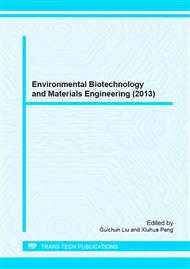p.56
p.60
p.65
p.71
p.77
p.82
p.86
p.92
p.96
Preparation of Photocatalyst of Nano-TiO2 Coating on SiO2 Carrier and its Photocatalytic Activity
Abstract:
The photocatalytic efficiency of TiO2 can be significantly improved by loading TiO2 on adsorption carriersSiO2 gel beads. The novel photocatalytic reagents can adsorb organic matters around the semiconductor particles, enhance the local concentration, prevent the intermediates from volatilizing and drifting away, and accelerate the reaction. The supporters depended on the micro-cystic cavity made of surfactant, sodium dodecyl sulfate and sodium silicate, aggregation spherical SiO2 colloidal particles taking sodium silicate as matrix, prepares TiO2/SiO2 catalyst by absorbing anatase TiO2 on the surface of hydroxide silicon. Characterization of the catalyst by SEM and XRD, and the photocatalytic activity through the degradation rate of humic acid are investigated. The experiments demonstrated that: the molar ratio of sodium silicate to sodium dodecyl sulfate (SDS) is 3/5 and the molar ratio of TiO2 to SiO2 is 1/8, the particle size of prepared catalyst is 0.5-30μm, and the TiO2/SiO2 catalyst showed ideal performance of adsorption and photocatalytic activity.
Info:
Periodical:
Pages:
77-81
Citation:
Online since:
September 2013
Authors:
Keywords:
Price:
Сopyright:
© 2013 Trans Tech Publications Ltd. All Rights Reserved
Share:
Citation:


